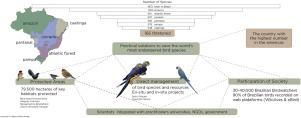Perspectives in Ecology and Conservation ( IF 4.0 ) Pub Date : 2021-03-03 , DOI: 10.1016/j.pecon.2021.02.005 Pedro Ferreira Develey

|
Brazil is among the three countries with the highest diversity of bird species in the Americas. However, it ranks first in number of threatened birds with 166 species. Changing this troubling scenario is not an easy task and requires the active involvement of society and engagement in practical conservation measures, besides gathering quality scientific information. Measures such as the implementation of protected areas, conservation initiatives on privately-owned lands and the direct management of certain species have contributed to reverse this status of threat to Brazil’s birds. In the last two decades public and private protected areas encompassing 79,500 hectares have been created specifically to protect some of the world's most endangered bird species such as the Blue-eyed Ground-dove (Columbina cyanopis), Alagoas Antwren (Myrmotherula snowi), and Cherry-throated Tanager (Nemosia rourei). The integration between ranchers and environmental sectors has also resulted in positive outcomes for the grasslands of southern Brazil, where 242 bird species (six of them globally threatened) are being conserved on private lands. Direct management was key to foster population growth in species such as the Hyacinth Macaw (Anodorhynchus hyacinthinus) in the Pantanal region. Population recovery is also the only hope for the Spix's Macaw (Cyanopsitta spixii) to return to nature, through a reintroduction program led by the Brazilian government in association with international partners. The active participation of society is also crucial and is bolstered by the recent growth in the number of Brazilian birdwatchers, currently estimated at between 30 and 40 thousand people. New web tools such as WikiAves, a community science website that provides access to over 3 million photographs of Brazilian birds, as well as eBird, are being used to store all the information generated by birdwatchers. Thanks to their contribution, many knowledge gaps regarding the distribution of Brazilian birds are being filled, while we nurture a society that is much more attentive to the cause of bird conservation. Even considering the inefficient and detrimental environmental policy of the current government, integrated practical actions backed by good scientific knowledge and civil society participation can help Brazil to reverse this alarming title of being the Americas’ number one country in number of endangered birds.
中文翻译:

巴西的鸟类保护:一个主要生物多样性大国的挑战和实际解决方案
巴西是美洲鸟类物种多样性最高的三个国家之一。但是,它在166种受威胁鸟类中排名第一。改变这种令人不安的情况并非易事,除了收集高质量的科学信息外,还需要社会的积极参与和采取切实可行的保护措施。诸如执行保护区,在私有土地上的保护计划以及对某些物种的直接管理等措施有助于扭转这种对巴西鸟类的威胁地位。在过去的二十年中,已经建立了占地79,500公顷的公共和私人保护区,专门用于保护一些世界上最濒危的鸟类,例如蓝眼睛的地面鸽子(Columbina cyanopis)),Alagoas Antwren(雪蛤Myrmotherula snowi)和樱桃喉的唐纳雀Tanager(Nemosia rourei)。牧场主与环境部门之间的融合也为巴西南部的草原带来了积极的成果,那里有242种鸟类(其中六种受到全球威胁)在私人土地上得到保护。直接管理对促进潘塔纳尔地区的风信子金刚鹦鹉(Anodorhynchus hyacinthinus)等物种的种群增长至关重要。人口恢复也是Spix的金刚鹦鹉(Cyanopsitta spixii)的唯一希望),通过巴西政府与国际合作伙伴共同发起的再引进计划,回归自然。社会的积极参与也是至关重要的,而且巴西观鸟者的人数最近有所增加,目前据估计该人数在3万至4万人之间。新的网络工具,例如WikiAves,这是一个社区科学网站,可用于访问超过300万张巴西鸟类的照片以及eBird,用于存储观鸟者产生的所有信息。由于他们的贡献,填补了关于巴西鸟类分布的许多知识空白,同时我们建立了一个更加关注鸟类保护事业的社会。即使考虑到现任政府的低效率和有害的环境政策,在良好的科学知识和民间社会参与的支持下采取的综合实际行动也可以帮助巴西扭转这一令人震惊的称号,成为美洲濒危鸟类数量第一的国家。









































 京公网安备 11010802027423号
京公网安备 11010802027423号